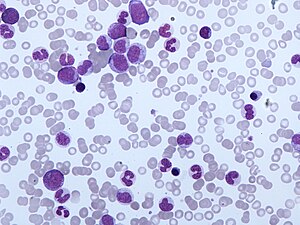Chronic myelomonocytic leukemia
| Chronic myelomonocytic leukaemia | |
|---|---|
 |
|
| Peripheral blood film of CMML. Monocytosis and the presence of myelocytes, metamyelocytes and promyelocytes is typical of CMML. | |
| Classification and external resources | |
| Specialty | Hematology and oncology |
| ICD-9-CM | 205.1 |
| ICD-O | M9945/3 |
| MeSH | D015477 |
Chronic myelomonocytic leukaemia (CMML) is a type of leukaemia, which are cancers of the blood-forming cells of the bone marrow. In adults, blood cells are formed in the bone marrow, by a process that is known as haematopoiesis. In CMML, there are increased numbers of monocytes and immature blood cells (blasts) in the peripheral blood and bone marrow, as well as abnormal looking cells (dysplasia) in at least one type of blood cell.
CMML shows characteristics of a myelodysplastic syndrome (MDS); a disorder that produces abnormal looking blood cells, and a myeloproliferative disorder (MPD); a disorder characterised by the overproduction of blood cells. For this reason CMML was reclassified as a MDS/MPN overlap disorder in 2002. For a diagnosis of CMML, the World Health Organisation (WHO) states that the blood monocyte count must be >1x109/L, no Philadelphia chromosome or mutations in the PDGFRA or PDGFRB gene should be present, the blast count must be <20% and dysplasia of at least one lineage of myeloid blood cell should be present.
Azacitidine is a drug used to treat CMML and is approved by the Food and Drug Administration (FDA) and the European Medicines Agency. Stem cell transplant is also used to treat CMML, and involves the transplantation of donor haematopoietic stem cells into the recipient. Blood transfusion and erythropoietin are used to treat disease associated anaemia.
...
Wikipedia
